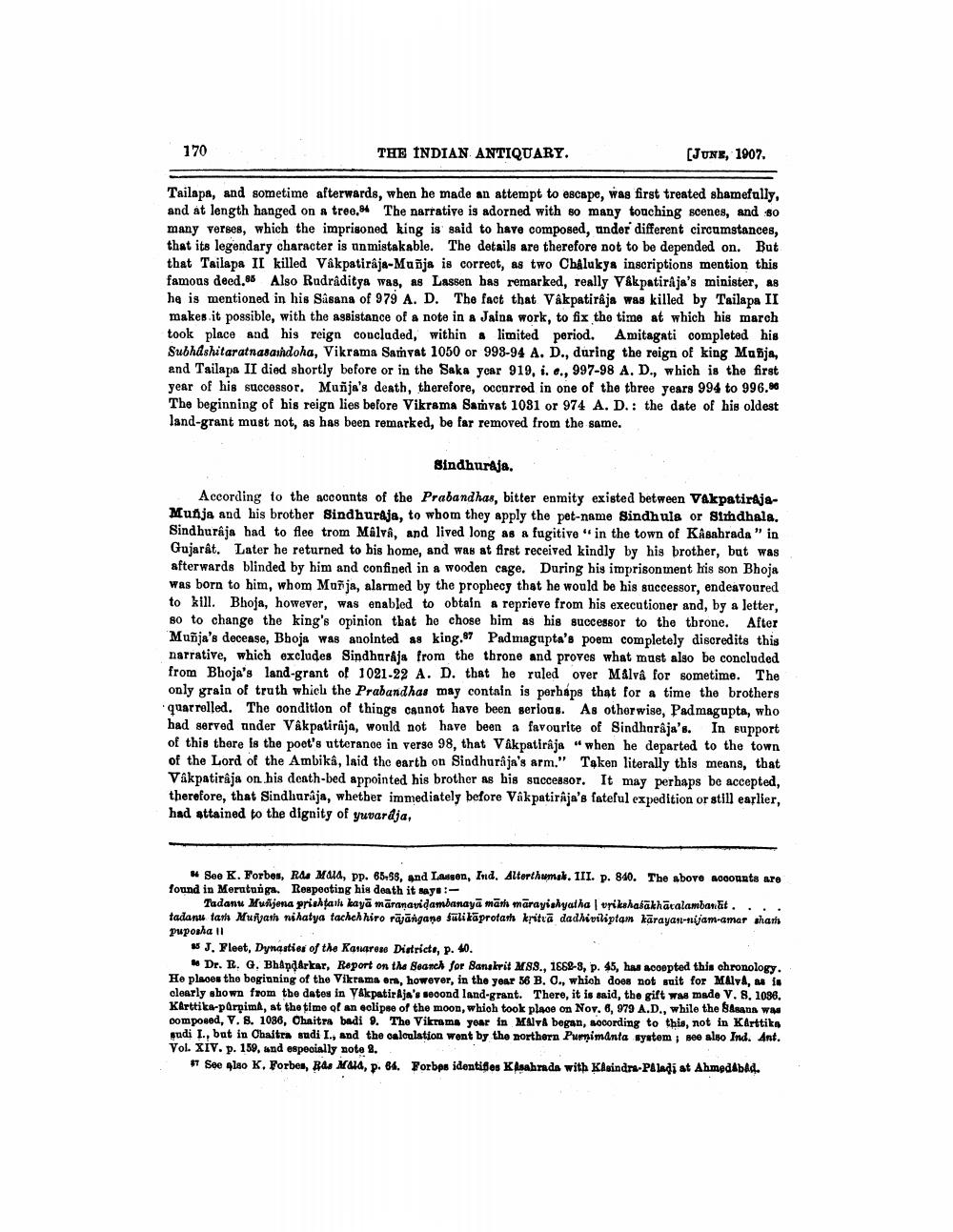________________
170
THE INDIAN ANTIQUARY.
(June, 1907.
Tailapa, and sometime afterwards, when he made an attempt to escape, was first treated shamefully, and at length hanged on a tree. The narrative is adorned with so many touching scenes, and so many verses, which the imprisoned king is said to have composed, under different circumstances, that its legendary character is unmistakable. The details are therefore not to be depended on. But that Tailapa II killed Vakpatiraja-Muñja is correct, as two Chalukya inscriptions mention this famous deed.86 Also Rodraditya was, as Lassen bas remarked, really Våkpatirâja's minister, as he is mentioned in his Sasana of 979 A. D. The fact that Vákpatirâja was killed by Tailapa II makes it possible, with the assistance of a note in a Jaina work, to fix the time at which his march took place and his reign concluded, within a limited period. Amitagati completed his Subhashitaratnasaidoha, Vikrama Samvat 1050 or 993-94 A. D., during the reign of king Muja, and Tailapa II died shortly before or in the Saka year 919, i. e., 997-98 A.D., which is the first year of his successor. Muñja's death, therefore, occurred in one of the three years 994 to 996. The beginning of his reign lies before Vikrama Samvat 1081 or 974 A.D. : the date of his oldest land-grant must not, as has been remarked, be far removed from the same.
Sindhuraja.
According to the accounts of the Prabandhas, bitter enmity existed between VakpatirdjaMunja and his brother Sindhuraja, to whom they apply the pet-name Sindh uls or simdhala. Sindhurâja had to flee trom Mâlva, and lived long as a fugitive" in the town of Kasabrada" in Gujarât. Later he returned to his home, and was at first received kindly by his brother, but was afterwards blinded by him and confined in a wooden cage. During his imprisonment his son Bhoja was born to him, whom Muñja, alarmed by the prophecy that he would be his successor, endeavoured to kill. Bhoja, however, was enabled to obtain a reprieve from his executioner and, by a letter, 80 to change the king's opinion that he chose him as his successor to the throne. After Muñja's decease, Bhoja was anointed as king.87 Padmagupta's poem completely discredits this narrative, which excludes Sindhardja from the throne and proves what must also be concluded from Bhoja's land-grant of 1021-22 A. D. that he ruled over Målva for sometime. The only grain of truth which the Prabandhas may contain is perhaps that for a time the brothers quarrelled. The condition of things cannot have been serious. As otherwise, Padmagupta, who had served under Våkpatiraja, would not have been a favourite of Sindhiraja's. In support of this there is the poet's utterance in verse 98, that Vâkpatiraja " when he departed to the town of the Lord of the Ambika, laid the earth on Sindhuraja's arm." Taken literally this means, that VÅkpatirâja on his death-bed appointed his brother as his successor. It may perhaps be accepted, therefore, that Sindhuraja, whether immediately before Vâkpatiraja's fateful expedition or still earlier, had attained to the dignity of yuvardja,
# See K. Forbes, Rua Maia, pp. 65,58, and Lassen, Ind. Alterthumak. III. p. 840. The above accounts are found in Merutunga. Respecting his death it sayo:
Tadanu Musljena prishtail kayā māranavidambanayā māti mārayishyatha vikahasākhāralambandi.... tadans tan Murjan ni hatya tachchhiro rājāngane fülikāprotan kritrā dadhiviliptam karayan-nijam-amar sham puposha 11
# J. Fleet, Dynasties of the Kanares Districts, p. 40.
• Dr. R. G. Bhandarkar, Report on the Beanch for Sanskrit M88., 1662-8, p. 45, ha acoepted this chronology. Ho places the beginning of the Vikrama on, however, in the year 56 B. O., whioh does not suit for Malva, mis clearly shown from the dates in yAkpatirAja's second land-grant. There, it is said, the gift was made V. 8. 1096. Karttika-pärpima, at the time of an eolipne of the moon, which took place on Nov. 8, 979 A.D., while the BAD WM composed, V. 8. 1086, Chaitra badi 9. The Vikrama year in MAIVA began, according to this, not in Karttiks Audi L., but in Chaitra sudi I., and the calculation went by the northern Purimanta system ; see aluo Ind. Ant. Vol. XIV. p. 159, and especially note 2.
$7 See 410 K. Forbes, Bas Mula, p. 84. Forbes identifies Asahnada with Kleindra-Paladi at Ahmedabad.




